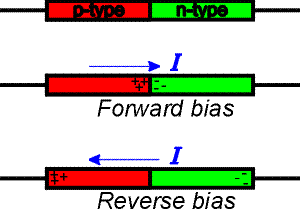 Diodes
are electrical components that allow current to flow in only one direction.
They are formed by joining p-type and n-type semiconductors as shown.
Diodes
are electrical components that allow current to flow in only one direction.
They are formed by joining p-type and n-type semiconductors as shown.Diodes
 Diodes
are electrical components that allow current to flow in only one direction.
They are formed by joining p-type and n-type semiconductors as shown.
Diodes
are electrical components that allow current to flow in only one direction.
They are formed by joining p-type and n-type semiconductors as shown.
If a voltage is applied across the diode with the p-type end positive (the "forward bias" case), any current that flows must flow from the p-type to the n-type material. The positive holes and the negative electrons both travel toward the boundary. When they meet there, the electrons happily fill the holes, so a steady current can easily flow: the resistance is small. The energy released when the electrons jump into the holes may even be released in the form of light, as in the familiar LED (Light Emitting Diode) device.
On the other hand, if a voltage is applied across the diode with the p-type end negative (the "reverse bias" case), any current that flows must travel in the opposite direction, so electrons and holes both travel away from the boundary. But there is no source of electrons and holes at the boundary, so very little current flows: the resistance is large. (If sufficient energy is available at the boundary region, it could spring an electron loose and thereby create a free electron and hole which would contribute to a current. That energy could be supplied by light, as in a photocell or video camera; or it could be caused by thermal fluctuations, as in a solid-state thermometer.)
In circuit diagrams a diode is represented by the symbol
![]() where the arrow
points in the direction current is allowed to flow.
where the arrow
points in the direction current is allowed to flow.